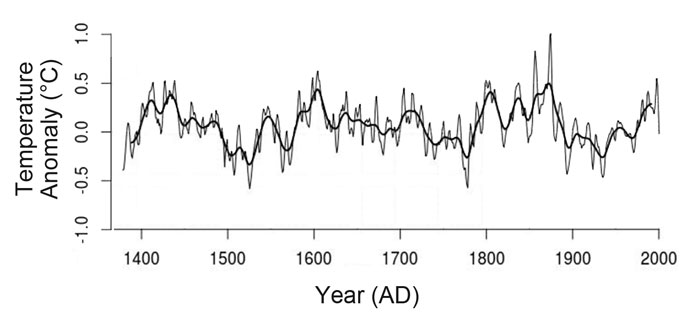| Tweet | Follow @co2science |
Paper Reviewed
Elbert, J., Jacques-Coper, M., Van Daele, M., Urrutia, R. and Grosjean, M. 2015. A 600 years warm-season temperature record from varved sediments of Lago Plomo, Northern Patagonia, Chile. Quaternary International 377: 28-37.
In the words of Elbert et al. (2015), "quantitative, highly resolved (annual to subdecadal) season-specific and spatially-explicit climate reconstructions for the past millennium are very important to place current climate changes into the context of long-term natural climate variability, and to discriminate the fingerprint of current anthropogenic forcing." Given the importance of such reconstructions, especially for locations in South America, where they are few in number compared with other well-studied continents, the team of five researchers set out to obtain a new multi-century temperature proxy for the northern region of Patagonia, Chile.
The site selected for analysis was Lago Plomo (46.98°S, 72.87°W), a proglacial lake located on the eastern side of the Northern Patagonian icefield. There, in 2011, the researchers retrieved a 3-m-long piston sediment core from the lake. Upon analysis of the core, the authors determined that total sediment brightness (% reflectance in the range of 400-730 nm) was a robust proxy for austral warm-season surface air temperatures (September-February).
The 600-year reconstructed record -- dating back to AD 1392 -- is depicted in the figure below. As indicated, the record shows pronounced periods of subdecadal to multidecadal variability. Specifically, Elbert et al. note the presence of cold phases "during parts of the Little Ice Age (16th and 18th centuries) and in the beginning of the 20th century." In contrast, they state that warm phases persisted "in the 15th century, around AD 1600 and in the 19th century," the latter of which they characterized as the "most prominent" of the entire record.

Figure 1. Warm season (September through February) temperature reconstruction from Lago Plomo. Lighter gray line represents 5-years filtered data, black line is 20 years filtered data. Adapted from Elbert et al. (2015).
With respect to the quality of their reconstruction, the five scientists write that it "compares favorably with independent regional and sub-continental temperature records," although there are some specific differences. Nevertheless, they conclude the new proxy to be "robust." The significance of this conclusion is recognized in conjunction with a statement made in the introduction to their paper, in which they note that "in general, the Southern Hemisphere mid- and high latitudes offer much better opportunities to detect the anthropogenic signal of climate change because the influence of natural forced variability is smaller," citing the works of Shindell and Schmidt (2004) and Fyfe et al. (2012). Thus, according to Elbert et al., the Lago Plomo record provides an excellent opportunity to determine what, if any, influence the modern rise in atmospheric CO2 has had on temperatures of this region of South America. And the answer to that inquiry is: nothing that is unusual, unnatural or unprecedented!
Thus, this study provides one more example of empirical evidence that stands in opposition to model-based claims that modern temperatures have been rising in response to increasing atmospheric CO2 concentrations.
References
Fyfe, J.C., Gillett, N.P. and Marshall, G.J. 2012. Human influence on extratropical Southern hemisphere summer precipitation. Geophysical Research Letters 39: L23711.
Shindell, D.T. and Schmidt, G.A. 2004. Southern Hemisphere climate response to ozone changes and greenhouse gas increases. Geophysical Research Letters 31: L18209.
Posted 4 December 2015



